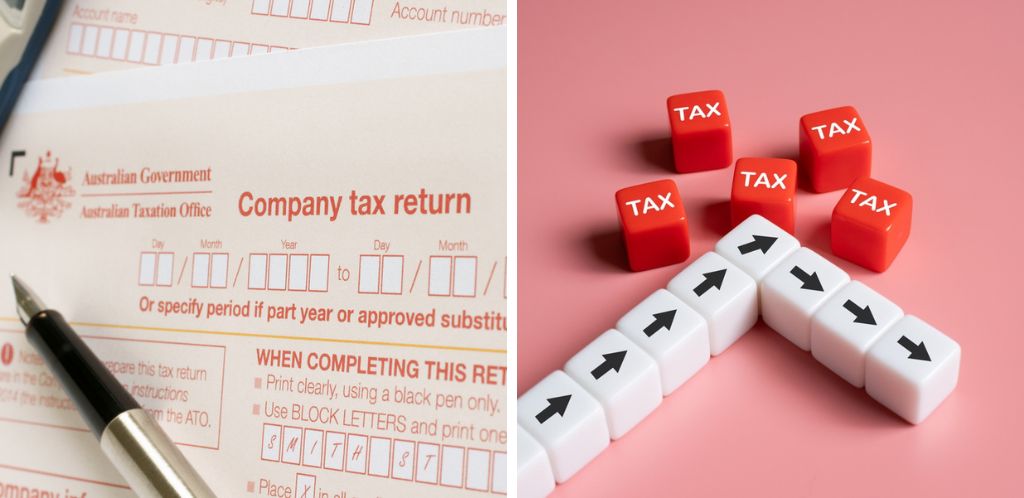Learn all about taxes in Australia: What should you pay?
All about taxes in Australia: what they are, how they work and the percentages to be paid. Also the tax benefits!
You might not expect it, but taxes in Australia are pretty reasonable, especially when compared to those in other developed countries. With a transparent and well-regulated system, the country ensures wealth is redistributed fairly and its welfare programs are well-funded. This setup allows both Aussies and expats to enjoy excellent public services.
Thinking about moving to Sydney, Melbourne, or anywhere else in Australia? Then this is worth a read. We’ll go over the main taxes for individuals and businesses, along with potential tax benefits you could take advantage of. Knowing how the tax system works is crucial before packing your bags or investing, as it can have a big impact on your lifestyle. Let’s explore it together!
Taxation for individuals in Australia
Let’s dive into how taxes work for individuals. When moving to a new country—whether it’s Australia or anywhere else—one of the first things you need to understand is the tax system. Ignoring your tax responsibilities can lead to trouble, and having a clear picture of them is essential for planning your finances.
Before we dive into the details of Australia’s tax system, there’s an important point to clarify—your tax obligations depend on whether you’re a resident or a non-resident. This distinction matters because it significantly affects the tax rates you’ll pay and the benefits you may be eligible for. Non-residents are only taxed on income earned within Australia, but they face higher tax rates. Now that we’ve covered that, let’s take a look at the main taxes individuals need to pay in Australia.

1. Income Tax
Let’s start with one of the most important taxes: income tax. It’s a key component of Australia’s tax system and applies to earnings from salaries, investments, rental income, and more. The system is progressive, meaning the higher your income, the higher the tax rate. Your classification as a tax resident or non-resident also plays a crucial role in how this tax applies.
- Tax residents: Pay tax on all their income. Those generated within Australia and also in other countries. The progressive rates are:
- Up to A$18,200 ($11,800): exempt.
- Between A$18,201 and A$45,000 ($11,801 and $29,200): 19%.
- Between A$45,001 and A$120,000 ($29,201 and $78,000): 32.5%.
- Between A$120,001 and A$180,000 ($78,001 and $117,000): 37%.
- More than A$180,000 ($117,001): 45%.
Sounds a bit confusing? Let’s break it down with an example. Suppose a tax resident earns A$70,000 ($45,500). They would pay 19% on the first A$45,000 and 32.5% on the remaining A$25,000 ($15,700). That adds up to roughly A$14,697 ($9,550) in taxes.
- Non tax residents: Only taxed on income earned within Australia. The tax rates for non-residents start at 32.5% from the very first dollar and go up to 45% for income over A$180,000 ($113,620).
Let’s look at an example for these cases: a non-resident earning A$90,000 ($58,500) per year would pay A$29,250 ($19,012) in taxes, since there’s no tax-free threshold for them.
2. Goods and Services Tax (GST)
The Goods and Services Tax (GST) is an indirect tax applied to most goods and services in Australia. It’s set at 10%, and while businesses collect it, the cost is ultimately passed on to consumers through the final price.
In other words, if you buy a product worth A$100 ($65), you will pay A$10 ($6.5) GST.
Basic food, medical services, education and other essential goods or services are exempt.
3. Capital Gains Tax (CGT)
Capital Gains Tax (CGT) is charged on the profits made from selling assets such as property, shares, or other investments. Essentially, it taxes the difference between the purchase price and the selling price if the asset has increased in value. The way this tax applies can vary quite a bit depending on whether you’re a resident or not.
- Tax residents: Taxed on global gains, but can benefit from a 50% discount if the asset is held for more than 12 months before being sold.
- Non-tax residents: Taxed only on gains from assets located in Australia and are not entitled to the 50% discount.
Here’s an example: Let’s say you’re a resident and you buy a property for A$500,000 ($325,000). After two years, you decide to sell it for A$700,000 ($455,000). In this case, your capital gain would be A$200,000 ($130,000), but you’d only be taxed on half of that amount—A$100,000 ($65,000). It’s important to note that CGT is added to your taxable income and taxed at the same progressive rates as your income tax, so how much you’ll pay depends on your total income.
4. Tax on rent
Income from renting out property is subject to income tax. However, you can deduct expenses related to maintaining the property, such as repairs, mortgage interest, and management fees.
Example: If you rent a property and generate A$25,000 ($16,250) a year, but have A$7,000 ($4,550) in deductible expenses, you will be taxed only on A$18,000 ($11,700).
5. Medicare Levy
The Medicare Levy is a 2% tax on the taxable income of Australian tax residents. Its main purpose is to help fund Australia’s public healthcare system, which provides essential medical services to the population.
If you earn a high income and don’t have private health insurance, the government may require you to pay an additional charge called the Medicare Levy Surcharge. It encourages people to take out private insurance and helps ease the strain on the public healthcare system. Depending on your income level, it can range from 1% to 1.5% of your taxable income.
For example, if you have taxable income of A$150,000 ($97,500) per year and you do not have insurance with health coverage, you could pay an additional surcharge of up to A$2,250 ($1,462) per year (on top of the standard 2%). This would bring your total to A$5,250 ($3,412).
6. Other specific taxes for individuals in Australia
So, those are the main taxes that apply to individuals in Australia, but they’re not the only ones. There are other specific taxes that may not affect everyone but are important in certain situations. These range from taxes on luxury goods to benefits related to employment, and they’re designed to address specific cases within the tax system.
- Motor Vehicle Duty: The government applies it when registering new or used vehicles, with rates varying depending on the state and the vehicle’s value. For example, some states charge between 3% and 5%, based on the price of the vehicle.
- Stamp Duty: Taxes the transfer of property and related contracts. The rates are progressive and depend on the value of the property acquired and the state where it is registered.
- Luxury Car Tax – LCT: This tax applies to luxury vehicles that exceed certain price thresholds. The rate is 33% on the amount that surpasses the limit, which currently ranges between A$69,152 and A$79,659 ($45,949–52,778), depending on the vehicle’s efficiency.
- Fringe Benefits Tax – FBT: Applies to employers for non-cash benefits granted to their employees, such as company cars or housing. The general rate is 47%.
- Specific levies for temporary residents: In some cases, those on a digital nomad visa in Australia or temporary residents may have to pay additional taxes related to public services or social benefits, depending on the type of visa they hold.
These taxes can vary based on your personal situation and location within Australia. If you think any of them might apply to you, it’s best to reach out to a local tax specialist for personalized advice. And make sure to get your Holafly eSIM so you can stay in touch with your expert at all times.
Important: If you are a frequent traveler and want to stay connected without worrying about expensive roaming or looking for a new SIM at every destination, Holafly’s subscription plans are for you. With a single eSIM, enjoy internet in more than 170 countries for a fixed price and no surprises on your bill. travel without limits and connect easily and securely! 🚀🌍

Taxation for legal entities or companies in Australia
Now let’s take a look at what happens if you start a business in Australia. The country is known for having a competitive and well-organized tax system for businesses. The tax framework combines both general and specific taxes that seek to balance the tax burden on companies and the country’s economic growth. The taxes you’ll pay depend on the type of business you establish, with different obligations for startups compared to large multinational companies.

1. Corporate Tax
The government applies the corporate tax to the net profits earned by businesses in Australia. It affects both local and foreign companies operating in the country.
- Standard rate: 30% for most companies.
- Reduced rate: Small companies with annual revenues of less than A$50 million ($32.5 million) will receive a 25% rate, provided that no more than 80% of these revenues come from passive investments.
To put it simply, if your business makes a profit of A$1,000,000 ($650,000) and qualifies for the reduced rate, you’ll pay A$250,000 ($162,500) in taxes. With the standard rate, the amount would be A$300,000 ($195,000).
2. Goods and Services (GST)
As we mentioned in the section on individual taxes, the GST is a cost that falls on consumers when they pay for goods or services. However, it’s the businesses that are responsible for managing this tax on each transaction and submitting it to the Australian Tax Office (ATO). This only applies to businesses generating over A$75,000 ($48,750) annually, as GST registration is mandatory for them.
3. Capital Gains Tax (CGT)
The CGT taxes the profits made from selling business assets, such as property, shares, or investments. It’s part of the corporate tax and doesn’t have a separate rate. Some businesses may qualify for exemptions or discounts if they meet certain criteria.
Example: If you sell a commercial property that you bought for A$500,000 ($325,000) and sell it for A$800,000 ($520,000), the taxable gain would be A$300,000 ($195,000), taxed at either 25% or 30%, depending on the circumstances.
4. Fringe Benefits Tax (FBT)
FBT applies to non-monetary benefits granted by companies to their employees. Examples include company cars, lodging or additional services.
- Standard rate: 47% of the value of the benefit.
- Taxable amount: Market value of the benefit less employee contributions.
Example: If your company supplies a company car valued at A$20,000 ($13,000) per year, the FBT will tax you A$9,400 ($6,110).
5. Other relevant taxes for businesses in Australia
In addition to the main taxes, there are other specific taxes that may apply depending on the sector or activities of the business:
- Payroll Tax: This tax is levied on wages paid by the company and varies by state or territory, with rates ranging from 4.75% to 6.85%.
- Stamp Duty: Applied to the purchase of commercial real estate, with rates varying according to value and location.
- Tax on commercial vehicles: Some regions impose an additional tax on businesses that use commercial vehicles as part of their operations.
Tax benefits in Australia
You’ll be happy to know that Australia offers some great incentives for both individuals and businesses. These incentives aim to promote investment, innovation, and attract talent. If you’re thinking of moving to cities like Melbourne or starting a business there, taking advantage of these benefits could help reduce your tax load and boost your returns.

1. R&D Tax Incentive
One of the most well-known programs for businesses in Australia aims to boost technological and scientific innovation by offering refundable tax credits or deductions.
- Small companies: Refundable tax credit of 43.5% on eligible research and development expenditures.
- Large companies: Non-refundable tax credit of 38.5%, but may be increased if the investment exceeds 2% of annual turnover.
Example: A small company investing A$500,000 ($325,000) in R&D can claim a refund of A$217,500 ($141,375).
2. Tax exemptions for small businesses
This country offers many tax benefits to support small and medium-sized companies:
- Instantaneous depreciation of assets: It allows businesses to immediately deduct the cost of assets purchased for less than A$150,000 ($97,500).
- Reduced corporate tax rate: As mentioned earlier, small businesses with annual revenues under A$50 million ($32.5 million) are taxed at a rate of 25%.
3. Incentives for foreign investors
Australia encourages international investment through tax treaties with over 40 countries. These agreements are designed to prevent double taxation and lower tax rates on dividends, interest, and royalties. Foreigners who pay taxes in Australia can benefit from:
- Tax reduction on dividends: According to the treaty, the rate may fall from 30% to 15% or even less.
- Capital gains tax benefits: Investments held for more than one year may benefit from a 50% discount in some cases.
4. Exemptions for temporary workers and international students
Temporary workers, digital nomads and students can take advantage of certain tax exemptions and benefits:
- Tax-free sections: Students working part-time are exempt from paying taxes if their annual income doesn’t exceed A$18,200 ($11,830).
- Discounts on educational expenses: You can deduct certain courses and materials if they are directly related to your current or future employment.
5. Priority development areas
The Australian government encourages investment in regional areas by offering additional tax benefits. These regions focus on industries such as mining, renewable energy, and agriculture.
- Extended deductions: Companies operating in these regions can claim deductions of up to 150 % on expenses related to sustainable projects.
Frequently asked questions about taxes in Australia
You must submit tax returns between July 1 and October 31 each year. If you work with an accountant or registered agent, you can request an extension. Be sure to stick to these deadlines to avoid late fees or penalties.
You can file your tax return through the MyGov platform, which connects to the Australian Taxation Office (ATO). Alternatively, you can do it with the help of a registered tax agent or accountant. Don’t forget to get your Holafly eSIM for Australia so you can reach out to them anytime with any questions. To get started, gather your Tax File Number (TFN) and documentation for your income and deductions.
As a tax resident in Australia, you must declare your global income, including any earned abroad. However, international tax agreements allow you to avoid double taxation by claiming credits for the taxes you’ve paid in other countries.
Tax residents in Australia can claim deductions for various work-related expenses, such as uniforms, tools, work travel, and job-related education courses. You can even claim expenses for working from home, like electricity and internet costs. Just be sure to keep all your receipts and documentation.
Failing to pay your taxes can lead to hefty penalties. The ATO imposes fines starting at A$222 ($145), which can increase over time or depending on the amount owed. Additionally, interest on your tax debt adds up every day.
Your TFN is important for getting a job in Australia and ensuring you don’t pay higher taxes. You also need it to open bank accounts and use financial services. You can apply for it directly on the ATO website.
If you’re a tax resident, the government will tax you on your worldwide income, and you can take advantage of tax-free thresholds and deductions. Non-residents, on the other hand, only pay taxes on income earned within Australia and don’t qualify for tax-free thresholds.
The ATO has online tools that help determine your tax residency based on your time spent in Australia, your employment and other factors.
Freelancers must report all income they earn from their services. In addition to income tax, if your earnings exceed A$75,000 ($48,750), you must register for GST and include a 10% tax on your invoices.





 Language
Language 


















 No results found
No results found







